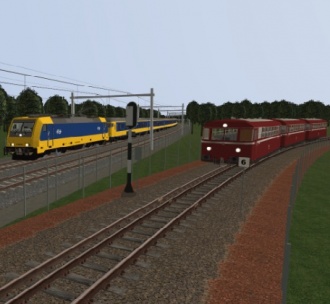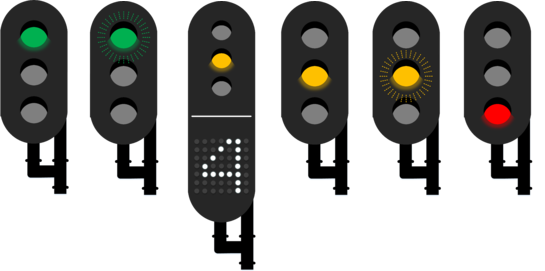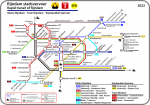Rijndam Railways 2022
| Rijndam |
|---|
Rijndam is a fictional city in Dutch style (made by Sjoerd Ydema), located along the river Rhine, with a metro network inspired by several different Dutch and non-Dutch metro networks.
There are seven versions of the Rijndam network:
- Rijndam 1985
- Rijndam 2006
- Rijndam 2016
- Rijndam 2018
- Rijndam 2020
- Rijndam 2022
- Rijndam Railways 2022
| Rijndam Railways 2022 |
|---|
|
General info Screenshot  Author: Sjoerd Ydema Lines: 2 Rijndam Rail lines, 8 NS services and 1 museumline Traction power supply: Overhead wire (and 3rd rail in the museumline) Description: Railways-only version of the original Rijndam 2022 MetroSim Version Required: Download:
|
|---|
|
Network information
Lines
There are 8 main NS services, 2 RijndamRail lines and a short museumline: Train-Protection Systems
|
|---|
|
Lines
Sprinter ServicesRijndam
Rijndam RailThe Railway Sprinter service (also known as "Rijndam Rail") runs from Rijndam Molenwijk trainstation to Noordvliet, via Rijndam Central station, Rijndam Westplein and Rijndam Buitenvelden, and from Rijndam Molenwijk trainstation to Ypenburg. Tickets from the metro network are also valid on the Railway Sprinter service. Zeeburg
Intercity Services
MuseumlineThe Museumline serves the metro transport museum which is located at the Wagenmakerstraat in Noordvliet. The line uses an old freight branch off the Rijndam - Panbos line. At the end of the line, a small depot has been build in order to preserve, maintain and display the historic metro trains. The line connecting the museum to the nearby Noordvliet station (on line M1) has been converted for use by these old metro trains; it has 3rd rail power supply and both ATB and ZUB train protection. Version 1.3: A meter gauge line has been added to 's Gravendijk, under Spanish signalling, for use by the FGV diesel train. Also, the connection to Noordvliet is dual gauge (1435mm and 1000mm) in this version. Destination codes:
|
||||||||||||||||||||||||||||||||||||||||||||||||||||||||||
|---|---|---|---|---|---|---|---|---|---|---|---|---|---|---|---|---|---|---|---|---|---|---|---|---|---|---|---|---|---|---|---|---|---|---|---|---|---|---|---|---|---|---|---|---|---|---|---|---|---|---|---|---|---|---|---|---|---|---|
|
Other locations
DepotsDepot MolenwijkDepot Molenwijk is the main depot on the network. It is situated near the Rijndam Molenwijk station. It has three sidings for railway rolling stock, used by NS and RijndamRail train services. The mechanics at Depot Molenwijk can also provide small maintenance for railway rolling stock. The depot also has 13 sidings for stabling up to 100 SG3-type metro trains, and a 6-track maintenance facility (a new building has replaced the old one from Rijndam 1985/2016). These sidings are out of service in this version of Rijndam. Depot BergensewegDepot Bergenseweg is a former freightyard near Bergenseweg metro station, connected to the railway line and to the out-of-service metro network at Station Westplein. After the national railway company abandoned it, it has been converted for use by the Rijndam metro network (power supply by overhead whires). Three tracks have been converted to serve as stabling facility for metro trains. The other tracks are not electrified and are available for stabling track maintenance rolling stock and/or out-of-service metro trains. There is also a short section of track leading to the docks at the Rhine river. As the metro network is not using it, NS and RijndamRail trains can be stored there. Depot DeniaDepot Denia, at the end of the Denia branch, contains 2 dual-gauge tracks which are connected to the first platform track at station Denia. Depot BuitenveldenDepot Buitenvelden is the Rijndam tram depot. It is out of service in this version of Rijndam. |
|---|
|
Misc
Railwaylines signals and securityThe railway lines in the Rijndam network are equiped with Dutch railway signals and ATB-EG security. The signs along the tracks are mostly the same as the signs used on the metro network, but there are a few differences. For example, the numbers on the blue stopsigns are in carriages of train length instead of the number of trainsets (a two-part train will stop at stopsign 2 on the railway network, where a MG2/SG2 metro will stop at stopsign 1 on the metro network). The following signals are being used to provide information on track clearance and speed limits:
The signals are backed up by ATB-EG security, controlling the maximum speed on the line. The signals are relayed to the trains by using the tracks to create a series of electromagnetic pulses, which are recognised by the equipment on board the trains. The ATB-EG system controlls the maximum speeds 40, 60, 80 and 130 km/h. However, the main rule remains "when more then one speed indication is given, the most restrictive one must be followed". So when signs along the track tell you the maximum speed is 100 km/h, and the ATB tells you 130, then you must keep to 100 km/h. The metro rolling stock will display (and enforce) the highest speed they can at or below the speed they receive from the ATB-EG; for example, if the ATB-EG sends out "130 km/h", the SG3 rolling stock will display "100", and the Bursa 5200's will display "80". Trivia
|
|---|
| Editions | ||
|---|---|---|
| Metro lines | ||
| Tram lines | ||
| RijndamRail lines | ||
| Other lines | ||
| Depots | ||
| Other locations | ||

